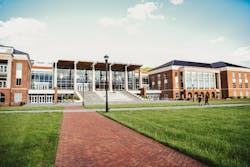5 Ways Tech is Transforming Campus Facilities Management
The pandemic hasn’t been easy for educational institutions. Even before 2020, America’s colleges were facing declining enrollment, spiraling student debt, and cuts to federal and state support. The emergence of COVID exacerbated those problems, and brought new challenges for educators, administrators—and perhaps even more so for property management teams tasked with keeping campuses safe and well-maintained.
Estate management teams are the backbone of any institution, and their diligence and professionalism has never been more important. Now, as colleges adapt to the “new normal,” they will be called on to dig deep again and address major new challenges.
Fortunately, with the right technologies, campus managers have an opportunity to level up their operations. Here are 5 key areas where estate teams can use digital tools to keep their institutions moving forward.
1. Hygiene
Keeping campuses clean has always been a priority for estate management staff—but in the post-pandemic era, hygiene is more important than ever.
With thousands of students and staff congregating from all around the world, it’s little surprise that American colleges have seen some of the country’s fiercest COVID outbreaks. Though overall cases of the virus remain relatively low, safety and hygiene are rightly top-of-mind for university leaders.
Campus staff performed admirably early in the pandemic, setting up sanitizer stations, testing centers, one-way systems and other social-distancing measures, and deep-cleaning schedules. As organizations pivot from emergency action to business-as-usual, the key is to avoid complacency and ensure standards don’t slip.
For this, digital checklists and cloud-based task management tools are invaluable, helping frontline teams to keep track of new protocols, ensure vital tasks don’t get neglected, and manage all the work orders and maintenance tasks required to keep their institutions safe.
2. Value for Money
Collectively, American graduates owe around $1.7 trillion in student loans, so it’s easy to see why enrollment rates are dipping. Part of the solution needs to be ensuring that colleges offer real value for money to students—and that depends in large part on the quality of their facilities.
Estate management leaders will need to find new ways to elevate the student experience. From technologically enhanced learning suites to social areas that bring communities together, campuses must adapt and grow in order to attract students.
Consider Roosevelt University’s “vertical campus”—a futuristic 32-story skyscraper in downtown Chicago that brings lecture halls, labs, dining halls, accommodation and administrative offices under one roof. It’s no surprise that Roosevelt is bucking the downward enrollment trend and is one of the country’s 10 fastest-growing colleges.
3. Sustainability
Another key way to attract students: make your campus a place where they can learn about and experience green construction, clean energy and more. Students are increasingly sustainability-minded, and hundreds of schools have made important environmental commitments—but fewer than 10 have achieved carbon neutrality, so there’s still room for eco-friendly campuses to differentiate themselves.
Some establishments, such as Carleton College, have gone all-out, installing wind turbines to meet 70% of their electricity demand. That’s a great move if your budget stretches that far, but you don’t have to break the bank to make a difference. Estate management teams can make real headway by focusing on energy efficiency, with better insulation and even window treatments capable of delivering meaningful results without plus-sized investments.
Internet of Things solutions can also help to ensure windows are open or shut at appropriate times, or track heating and cooling to ensure HVAC systems are operating efficiently. Mindfulness is key: make sure your procurement strategies factor in sustainable sourcing and find ways to repurpose or upgrade existing facilities wherever possible.
4. Maintenance
As every property manager knows, when organizations start cutting costs, maintenance budgets are often among the first to suffer. That’s especially tough in the education sector: many U.S. colleges were constructed during periods of rapid expansion in the early and mid-1900s, so large numbers of school buildings are showing signs of aging.
For campus administrators, that adds up to a major deferred-maintenance headache. The cost of outstanding repair work is estimated at $100 per square foot, so American universities—with a collective campus area of more than 6 billion square feet—could face billions of dollars in maintenance costs.
To rise to that challenge, estate management teams can use smart property-management and task-tracking tools to both stay on top of existing maintenance work, and to audit their campuses for tasks that have been neglected over a period of years or decades. Advanced analytics can turn the deluge of data produced by school facilities into actionable insights, helping teams to work smarter, and assign limited maintenance resources to the places where they’re most needed.
5. The Digital Future
Bringing new technologies into the property management space makes the entire campus smarter, delivering benefits for everyone from students and faculty to frontline maintenance teams to senior administrators.
With greater visibility and transparency at every stage of the process, property managers can make scribbled logbooks a thing of the past and use digital work orders to track tasks and provide clear accountability. That can also help document the need for additional investments and the ROI that campus decision-makers can expect as they invest in their estate portfolio.
As campus administration grows ever-more complex, this boost to efficiency and collaboration will be key. Whether it’s using cloud tools and “virtual campus” models to track operations in real time, or task-management systems to flag problems and keep staff and subcontractors working efficiently, the future of estate management is undoubtedly digital.
Rising to the Challenge
For today’s university estate management teams, keeping campuses operating smoothly is far more challenging than it was even a decade ago. The pandemic has piled pressure on staff charged with keeping campuses clean and well-maintained, even as campuses are seeking to do more with less, and to think creatively about how they can use their facilities to drive value for their students.
There’s no single solution to these challenges. But organizations that embrace new technologies will find they’re able to build out solutions that simultaneously deliver increased efficiencies, increased resilience, and increased value for everyone who uses the campus. Data and digitization aren’t just nice-to-have capabilities — for today’s campuses, they’re the key to success in an increasingly complex and challenging world.
About the Author:
Sander Van de Rijdt is the cofounder and co-CEO of PlanRadar, a digital platform for documentation, task management and communication in construction and real estate projects, serving more than 100,000 users across 60+ countries.
About the Author

Contributed Author
BUILDINGS partners with industry experts to bring you contributed content covering the hot topics for building owners and facility professionals.
